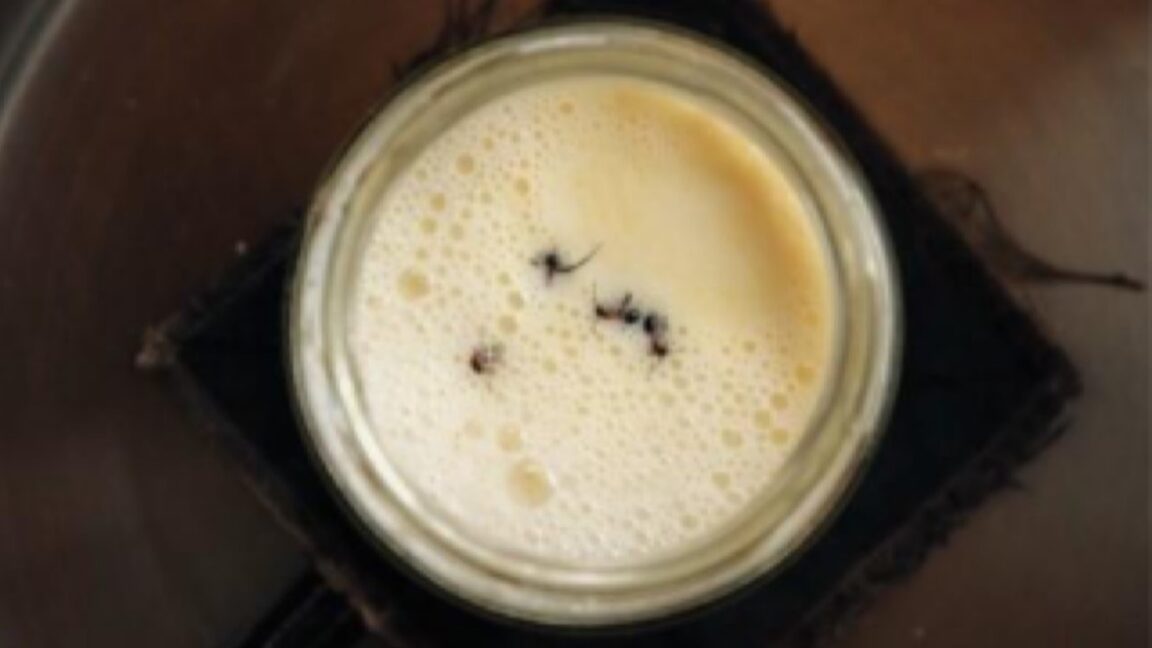Science
Scientists Revive Ancient Bulgarian Yogurt Recipe Using Ants

Researchers have successfully revived a traditional Bulgarian yogurt-making method that incorporates red wood ants. This unique practice, which dates back centuries, uses live ants or their eggs to initiate fermentation. A recent study published in the journal iScience explains the scientific basis behind this method, revealing how ants contribute to the yogurt’s unique flavor and texture.
The forests of Bulgaria and Turkey are home to numerous red wood ants, which have been utilized in local yogurt production for generations. According to Leonie Jahn, a co-author from the Technical University of Denmark, “Today’s yogurts are typically made with just two bacterial strains… Traditional yogurt has much bigger biodiversity, varying based on location, households, and season.” This diversity enhances the overall culinary experience.
Reviving Tradition with Scientific Methods
To recreate this ancient yogurt, the research team traveled to Nova Mahala, Bulgaria, where co-author Sevgi Mutlu Sirakova has family ties. Following her uncle’s guidance, they used fresh raw cow milk, heated until it was scalding, and added four live red wood ants sourced from a local colony. The mixture was then secured in cheesecloth and insulated with fabric before being buried in the ant colony for fermentation.
After approximately 26 hours, the team retrieved the container and found that the milk had thickened, indicating the early stages of yogurt formation. Tasters described the resulting product as “slightly tangy, herbaceous,” with distinct notes of “grass-fed fat.”
To further investigate the fermentation process, the authors conducted laboratory experiments using worker ants collected in Denmark. They created three variations of yogurt under sterile conditions, utilizing live, frozen, and dehydrated ants. The research revealed that red wood ants harbor both lactic and acetic acid bacteria, essential for coagulating the milk.
Innovative Culinary Applications
In an effort to promote this ancient method, the authors partnered with Alchemist, a prestigious two-Michelin-star restaurant in Copenhagen. Renowned for its emphasis on molecular gastronomy, the restaurant’s chefs reimagined the ant yogurt in several innovative dishes. They developed an “ant-wich,” which is an ice cream sandwich made with ant yogurt ice cream, and an “ant cheese” similar to mascarpone. Another creation was a cocktail clarified with ant milk wash, reminiscent of the historical Milk Punch.
Despite the culinary potential, the authors caution against home attempts to recreate this yogurt. They highlight safety concerns, as ants may carry parasites harmful to human health. “We advise practitioners to maintain this as part of their heritage and cultures of food safety, or to possess knowledge in food microbiology to ensure adequate safety,” they noted.
While the concept of ant yogurt may seem unappealing to some, many cultures around the world have long considered insects a delicacy. For instance, indigenous Brazilian communities have consumed Ica leafcutter ants for centuries, often referred to as “Brazilian caviar.” This research underscores the rich tapestry of culinary traditions and the potential benefits of integrating ancient practices into modern gastronomy.
The study not only sheds light on the unique aspects of traditional yogurt-making but also emphasizes the importance of biodiversity in food production. It serves as a reminder of the value of preserving culinary heritage while exploring innovative applications in contemporary cuisine.
-

 Education3 months ago
Education3 months agoBrandon University’s Failed $5 Million Project Sparks Oversight Review
-

 Science4 months ago
Science4 months agoMicrosoft Confirms U.S. Law Overrules Canadian Data Sovereignty
-

 Lifestyle3 months ago
Lifestyle3 months agoWinnipeg Celebrates Culinary Creativity During Le Burger Week 2025
-

 Health4 months ago
Health4 months agoMontreal’s Groupe Marcelle Leads Canadian Cosmetic Industry Growth
-

 Technology3 months ago
Technology3 months agoDragon Ball: Sparking! Zero Launching on Switch and Switch 2 This November
-

 Science4 months ago
Science4 months agoTech Innovator Amandipp Singh Transforms Hiring for Disabled
-

 Education3 months ago
Education3 months agoRed River College Launches New Programs to Address Industry Needs
-

 Technology4 months ago
Technology4 months agoGoogle Pixel 10 Pro Fold Specs Unveiled Ahead of Launch
-

 Business3 months ago
Business3 months agoRocket Lab Reports Strong Q2 2025 Revenue Growth and Future Plans
-

 Technology2 months ago
Technology2 months agoDiscord Faces Serious Security Breach Affecting Millions
-

 Education3 months ago
Education3 months agoAlberta Teachers’ Strike: Potential Impacts on Students and Families
-

 Science3 months ago
Science3 months agoChina’s Wukong Spacesuit Sets New Standard for AI in Space
-

 Education3 months ago
Education3 months agoNew SĆIȺNEW̱ SṮEȽIṮḴEȽ Elementary Opens in Langford for 2025/2026 Year
-

 Business4 months ago
Business4 months agoNew Estimates Reveal ChatGPT-5 Energy Use Could Soar
-

 Technology4 months ago
Technology4 months agoWorld of Warcraft Players Buzz Over 19-Quest Bee Challenge
-

 Business3 months ago
Business3 months agoDawson City Residents Rally Around Buy Canadian Movement
-

 Technology2 months ago
Technology2 months agoHuawei MatePad 12X Redefines Tablet Experience for Professionals
-

 Business3 months ago
Business3 months agoBNA Brewing to Open New Bowling Alley in Downtown Penticton
-

 Technology4 months ago
Technology4 months agoFuture Entertainment Launches DDoD with Gameplay Trailer Showcase
-

 Technology4 months ago
Technology4 months agoGlobal Launch of Ragnarok M: Classic Set for September 3, 2025
-

 Technology4 months ago
Technology4 months agoInnovative 140W GaN Travel Adapter Combines Power and Convenience
-

 Science4 months ago
Science4 months agoXi Labs Innovates with New AI Operating System Set for 2025 Launch
-

 Top Stories2 months ago
Top Stories2 months agoBlue Jays Shift José Berríos to Bullpen Ahead of Playoffs
-

 Technology4 months ago
Technology4 months agoNew IDR01 Smart Ring Offers Advanced Sports Tracking for $169










